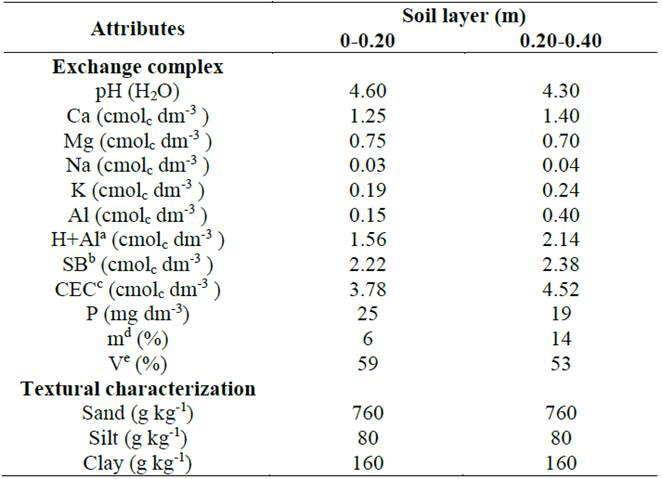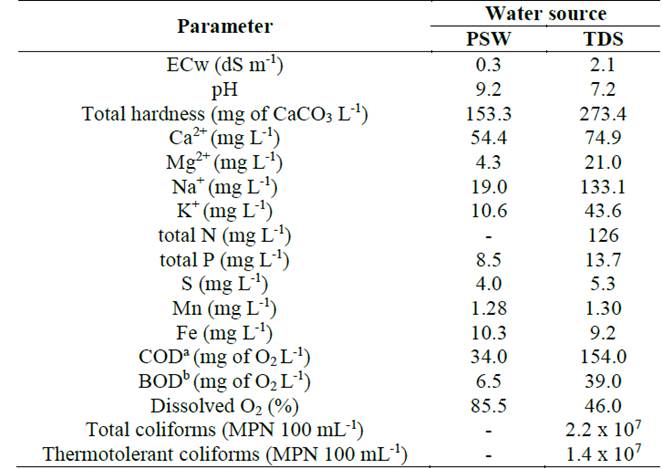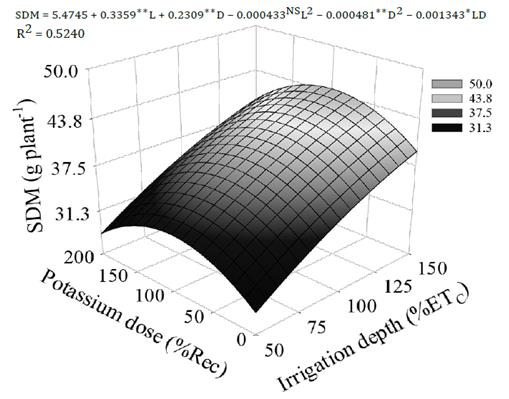1. Introduction
The use of treated domestic wastewater, besides increasing water supply to agriculture, leads to saving of potable water for domestic use, nutrition of plants and nutrient cycling, improves soil fertility, reduces the environmental impacts caused by the disposal of effluents directly into water courses [5,13].
In cotton, studies on the use of treated domestic wastewater have allowed the saving of nutrients applied through mineral fertilization and led to higher growth and biomass accumulation in this species [17,15].
Potassium (K) has recognized importance in plant physiology, being considered as the main inorganic cation due to its role in enzymatic activity, maintenance of ionic balance, osmotic potential and water absorption, and stomatal regulation [14,10].
Cotton has indeterminate growth habit, requiring K concentrations that are sufficient for its growth. Thus, the absorption of this nutrient has impact on the growth and yield of this species [4].
Potassium deficiency may lead to reduction in leaf expansion and photosynthetic capacity, affecting plant growth. In addition, it has been reported as a problem in soils where cotton is cultivated because K reserve is not sufficient to meet the amounts extracted by the crop [4].
Given the above, this study aimed to investigate the agronomic performance of colored cotton under irrigation depths with treated domestic wastewater and K doses in the semi-arid region of Pernambuco, Brazil.
2. Material end methods
2.1. Location and description of the experimental area
The experiment was carried out from April 15 to August 30, 2016, under field conditions, at the Unit for Agricultural Reuse of Domestic Sewage, belonging to the Agricultural Engineering Department of the Federal Rural University of Pernambuco, situated in the municipality of Ibimirim, Pernambuco state, 334 km away from the capital, Recife. The experimental area is located between 8° 32′ 05″ S and 37° 41′ 50″ W, at mean altitude of 408 m.
The climate of the region is classified as BSh (very hot semi-arid) according to Köppen’s classification [3], with mean annual rainfall of 454 mm. Cumulative rainfall of 122 mm and average temperature of 24.6 °C were recorded along the experimental period (Fig. 1).
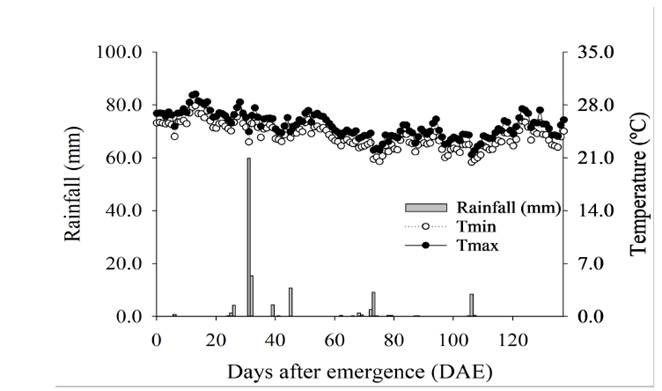
Source: The Authors.
Figure 1. Rainfall (mm) and daily maximum and minimum air temperature (°C) during the cotton development cycle.
The soil in the experimental area was classified as Neossolo Quartzarênico órtico típico (Entisol), with moderate A horizon, hyperxerophilic Caatinga phase, on a predominantly flat relief. Soil samples were collected in the 0-20 and 20-40 cm layers. The soil had a sandy loam texture with 760, 80 and 160 g kg-1 of sand, silt and clay, respectively, and its chemical characterization is presented in Table 1.
2.2. Experimental design and treatments
The experimental design was randomized blocks in a (5 x 5) + 1 factorial scheme, forming 26 treatments, with four replicates, totaling 104 experimental plots. Treatments consisted of five irrigation depths (L), corresponding to 50, 75, 100, 125 and 150% of crop evapotranspiration (ETC), using domestic wastewater treated by a UASB (Upflow Anaerobic Sludge Blanket) reactor (Table 2), and five K doses (D), corresponding to 0, 50, 100, 150 and 200% of the dose recommended for cotton, and an absolute control (AC) irrigated with public supply water (PSW) according to crop water need (100% ETC) and fertilized with N-P-K, 100% of the recommendation, based on soil analysis and according to the fertilization recommendation for the Pernambuco State [12]. The experimental plot was 15 m2, comprising three 5.0-m-long single rows spaced by 1.0 m, with 0.20 m distance between plants, and evaluations were carried out in the central row, disregarding 1.0 m on each end.
2.3. Irrigation management
Irrigation management was carried out according to the climate along the development of the crop. ETC was calculated based on the daily reference evapotranspiration (ETO) estimated by the FAO Penman-Monteith method [2], crop coefficient (KC) proposed by [6] and location coefficient according to [1].
Irrigation depths (L) were characterized by the irrigation time (Ti) established for each treatment on a daily irrigation frequency (IF).
After crop establishment and thinning, 25 days after emergence (DAE), the irrigation depths began to be differentiated by introducing the correction factor “F” in the calculation of Ti, corresponding to 0.50, 0.75, 1.00, 1.25 and 1.50 for the irrigation depths established according to the above-mentioned treatments. At the end of the experiment, 135 DAE, the cumulative irrigation depth was 307.75, 461.62, 615.49, 769.36 and 923.24 mm for the treatments with 50, 75, 100, 125 and 150% ETC, respectively.
A drip system was used for irrigation and the lateral lines had pressure-compensating drip tapes (Dripnet PC 16250, Netafim, Tel Aviv, Israel) with nominal diameter and flow rate of 16 mm and 2.0 L h-1, respectively, and drippers spaced by 0.30 m. A horizontal axis centrifugal pump (Schneider, Rueil-Malmaison, France) of 735.5 W was used for the effluent suction.
2.4. Fertilization management
Fertilization with KCl (60% K2O) was split: 50% of the recommended dose was applied in the planting furrow at 0.10 m depth before sowing, 25% was applied after thinning as top-dressing in a furrow 0.05 m away from the planting row at 0.10 m depth, and the remaining 25% was applied 20 days after the penultimate application, and the fertilizer was manually distributed in the furrows, totaling 0, 20, 40, 60 and 80 kg of K2O ha-1 for 0, 50, 100, 150 and 200% of the recommended dose, respectively.
The same management was carried out for the absolute control, applying the formulation with 90-40-40 kg ha-1 of N, P2O2 and K2O according to the fertilization recommendation for Pernambuco state [12]. Urea (45% N) was used as source of nitrogen, single superphosphate (20% P2O2) as source of phosphorus and potassium chloride (KCl, 60% K2O) as source of potassium. Phosphorus was applied all at once, at planting. For nitrogen and potassium, 50% of the recommended dose was applied at planting and the remaining 50% was split and applied as top-dressing, 25% after thinning and 25% at 20 days after the penultimate application.
2.5. Crop management
Cotton was planted in a furrow at 0.05 m depth, by placing five seeds at each 0.20 m interval in the furrow, leaving 10 plants per linear meter after thinning. Invasive plants were manually controlled using a hoe, keeping the area free from weeds in the period from seedling emergence to 40 DAE, when the crop reached full vegetative stage, entering early flowering.
2.6. Analyzed variables
2.6.1. Morphological responses
At 130 DAE, four plants were evaluated for height (H), considered as the distance from collar to apex, measured with a tape measure; stem diameter (SD), considered as the mean of the largest and smallest diameter measurements, measured with a digital caliper at 2.0 cm from soil surface; leaf area (LA, cm2 plant-1), obtained by the sum of the leaf area (Y) of each leaf, measuring the midrib length (X), according to the methodology proposed by [8], using eq. (1).
2.7. Statistical analysis
The data were subjected to analysis of variance. When there was significant effect of the interaction, the means were fitted with multiple regression models (response surfaces) considering the irrigation depths (L) and doses (D) as independent variables. The statistical package SAS 9.0 for Windows (SAS Institute, Inc., Cary, NC, USA, 2001) was applied, using the procedures PROC GLM for variance analysis, PROC REG for regression analysis and PROC RSREG for response surface analysis [22].
3. Results and discussion
The interaction between irrigation depths with treated domestic wastewater (L) and K doses (D) had significant effect at p < 0.05 on plant height (H) and at p < 0.01 on leaf area (LA), shoot dry matter (SDM), leaf area ratio (LAR) and seed cotton weight (SCW). Stem diameter was only affected by the factor irrigation depth (L) (Tables 3 and 4).
Table 3. Summary of analysis of variance for cotton height (H), stem diameter (SD), leaf area (LA).

(**), (*) and (NS) significant at 0.01 and 0.05 probability levels and not significant, respectively.
Source: The Authors.
3.1. Morphological responses
Maximum height of colored cotton (H = 83.84 cm) was obtained when the irrigation depth with treated domestic wastewater increased to 146% ETC, combined with 80% of the K2O dose recommended for the crop (Fig. 2a). The absolute control (AC), under the studied conditions, obtained mean height of 69.3 cm.
Higher irrigation depths favored greater water availability in the soil, which under these conditions allowed greater stomatal opening and consequently higher photosynthetic assimilation, contributing to greater plant height. Conversely, irrigation deficit leads to lower growth in height [11].
Evaluating three irrigation regimes, namely: saturation, regular and deficit, i.e., 120, 100 and 80% field capacity, [21] found significant differences for the studied conditions, observing greater plant height at saturation, followed by the regular regime and then deficit irrigation.
[15], evaluating the growth of cotton fertigated with wastewaters in the semi-arid region of Minas Gerais, found that the use of these waters causes higher plant growth compared with the control treatment, irrigated with public-supply water and under mineral fertilization. These authors attribute this effect to the greater supply of nitrogen and phosphorus to the plants, leading to higher growth.
Table 4. Summary of analysis of variance for shoot dry matter (SDM), leaf area ratio (LAR) and seed cotton weight (SCW).

(**), (*) and (NS) significant at 0.01 and 0.05 probability levels and not significant, respectively.
Source: The Authors.
Plant growth data were described by a quadratic model as a function of K application in the soil. The maximum dose causing maximum height was inferior to the 100% recommended for the crop, which can be attributed to the K concentration available in the treated domestic wastewater.
Cotton growth in height was probably influenced by the K present in the wastewater because K supply modulates various physiological processes in plants, and the main one is the regulation of cell osmotic balance, which allows cell turgor and consequently cell expansion, leading to plant growth [20,9].
SD was only influenced by irrigation depths with treated domestic wastewater and its maximum value (10.71 mm) was obtained with 150% ETC irrigation depth, based on the regression equation obtained. For the absolute control, the mean value of SD was 10.10 mm (Fig. 2 b ).
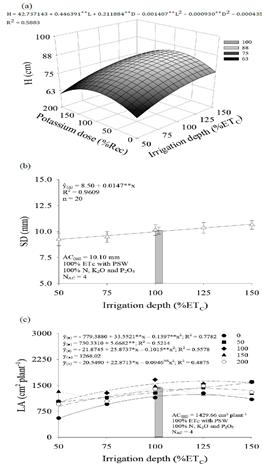
Source: The Authors.
Figure 2 Plant height (A), stem diameter (B) and leaf area (C) of colored cotton, cv. ‘BRS Rubi’, as a function of the applied treatments. **, * and NS significant at 0.01 and 0.05 probability levels and not significant, respectively. Vertical bar indicates the value of the absolute control.
The 100% ETC irrigation depth led to the same SD as that in the absolute control, which may indicate that the amount of nutrients present in the treated domestic wastewater was sufficient to meet the requirement of the crop along its development, without the need for K nutrition, causing the plant to maintain the same stem diameter.
Maximum LA was obtained with the combination of L = 127% ETC and D = 100% of the dose recommended for the crop, equal to 1627 cm2, and was obtained by the eq. (2):
Irrigation depths and K doses above these percentages reduce leaf expansion. The absolute control showed leaf area of 1429 cm2 (Fig. 2c).
Foliar maintenance in cotton plants is associated with adequate K supply because this nutrient has important function in cell osmotic balance. Thus, plants that received the percentages which caused higher LA had higher number of leaves with greater expansion. However, K demand can vary depending on the phenological stage of cotton.
The increase in LA caused by the increment in the levels of the studied factors, up to the maximum combination discussed previously, results from the accumulation of photoassimilates during photosynthesis [19], leading to higher dry matter accumulation in the plants, as indicated in Fig. 3.
3.2. Accumulation of dry mass
SDM increased linearly as a function of the replacement using treated domestic wastewater (L) and quadratically as a function of K fertilization (D). Among the studied levels of each factor, the combination between 150% ETC irrigation depth and 50% of the dose recommended for the crop caused highest SDM accumulation, 46.39 g plant-1 (Fig. 3). The absolute control showed SDM of 34.8 g.
The increase in SDM caused by the factor irrigation depth (L) may result from the accumulation of nutrients present in the treated domestic wastewater such as N, P and K (mean concentrations of 126.0, 13.7 and 43.6 mg L-1, respectively) and of photoassimilates during photosynthesis [17,19].
As observed, greater water availability increases stomatal opening, favoring the entry of CO2 in the mesophyll, thus enhancing photosynthesis [18].
Considering 100% ETC replacement with treated domestic wastewater, SDM was equal to 34.73 g, which is similar to the value accumulated by the AC. This result indicates that only irrigation with 100% ETC caused an accumulation of nutrients with no need for mineral supplementation under the studied conditions. Similar results have also been found by [17] and [15], who observed that irrigation with wastewaters can replace mineral fertilization, because they provide sufficient amounts of nutrients for plants.
In relation to K doses, the quadratic effect observed, combined with the irrigation depths, can be associated with the intensification of the osmotic effect caused by the fertilizer used (KCl) along with the salts present in the wastewater, at concentrations of 74.9, 21.0, 133.1 and 43.6 mg L-1 for calcium, magnesium, sodium and potassium, respectively, with electrical conductivity of 2.1 dS m-1.
3.3. Leaf area ratio
LAR expresses the photosynthetic capacity of the plant and its maximum value (42.0 cm2 g-1) was obtained with 200% of the K dose recommended for the crop and 125% ETc irrigation using treated domestic wastewater (Fig. 4). However, percentages higher than those negatively affect LAR. The absolute control showed LAR of 41.0 cm2 g-1.
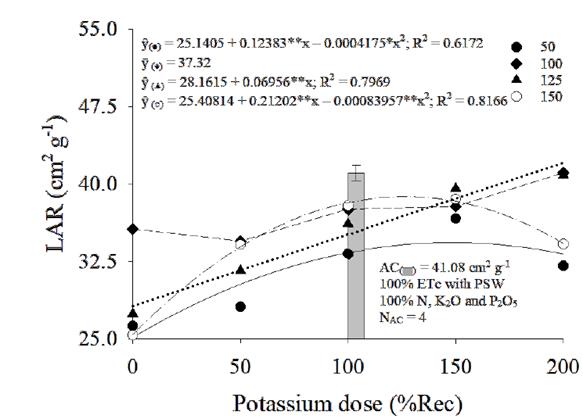
Source: The Authors.
Figure 4. Follow-up test of the interaction for leaf area ratio (LAR) of colored cotton, cv. ‘BRS Rubi’, as a function of irrigation depths with treated domestic wastewater (L) and potassium doses (D). **, * and NS significant at 0.01 and 0.05 probability levels and not significant, respectively. Vertical bar indicates the value of the absolute control.
Greater K supply in the soil resulted in higher leaf area ratio, which can be associated with the modulation of this nutrient in the osmotic regulation, leading to greater water influx into the cells with consequent increase in leaf turgor and expansion [20,9]. Thus, it increases this quotient since LAR represents the ratio between the assimilatory tissue of the plant (LA) and the shoot dry matter resulting from photosynthesis (SDM).
3.4. Seed cotton weight
Based on the multiple regression equation, maximum physical yield of seed cotton estimated by the SCW was obtained with the combination between L = 150% ETc and D = 100% under the studied conditions, 38.15 g plant-1 (Fig. 5). The absolute control produced 28.87 g plant-1.
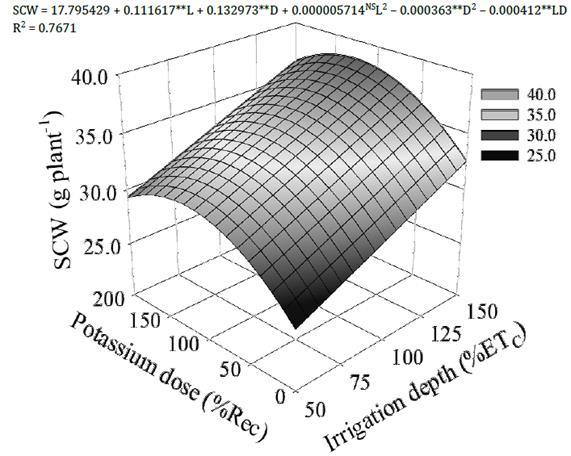
Figure 5. Response surface for seed cotton weight (SCW) of colored cotton, cv. ‘BRS Rubi’, as a function of irrigation depths (L) and potassium doses (D). **, * and NS significant at 0.01 and 0.05 probability levels and not significant, respectively.
The results of the present study corroborate those of [23], who observed increase in cotton yield as water replacement increased, and are also consistent with those found by [7], who observed quadratic fit of cotton yield with higher K supply in the soil and in the leaf.
When the crop received only the irrigation necessary to replace 100% ETC using treated domestic wastewater, SCW was equal to 29.0 g plant-1, similar to the value obtained in the absolute control. Thus, it can be noted that irrigation with treated domestic wastewater alone, with no need for K nutrition, leads to satisfactory yield with consequent saving of water and nutrients applied in mineral fertilization.
4. Conclusions
Our findings indicate that the use of treated domestic sewage to replace a depth of 100% ETC promotes greater gains in yield and growth of colored cotton, with 100% saving of drinking water and potassium via mineral fertilization, being a sustainable alternative source of water for the semi-arid region.













